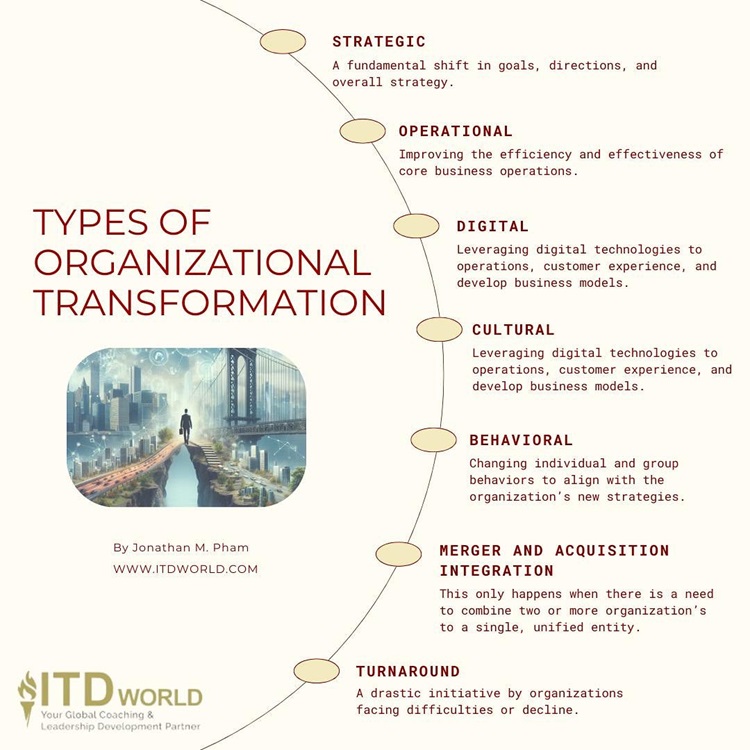Feeling lost in the face of change? This guide unlocks the secrets of successful organizational transformation, from building a vision to overcoming challenges.
In today’s dynamic business landscape, staying stagnant can spell disaster. Organizational transformation, the process of aligning your company with future goals, is no longer optional. That said, navigating this complex journey requires a roadmap. This article equips you with the knowledge and strategies to implement successful change, empowering your business to thrive in the face of uncertainty.
|
Author: Jonathan M. Pham |
Highlights
- Organizational transformation is a strategic redesign of a company’s structure, processes, and culture to improve performance and navigate future challenges. Organizational Development (OD) acts as the fueling engine – by advocating for change, guiding the process, facilitating employee buy-in, building employee capabilities, and shaping a supportive culture.
- The ever-changing business world, driven by technology, customers, competition, and workforce demands, means that transformation is no longer a luxury – but a must for companies to survive and thrive. In case one notices signs such as declining performance, customer dissatisfaction, low morale, or disruptive changes, it’s time for the organization to go through a revamp.
- Organizational transformation can target various aspects of a company, from overall strategy to company culture and employee behavior. Many frameworks may be utilized to guide the process – with Lewin’s 3-stage approach focusing on managing change and the Center for Organization Design’s model emphasizing alignment across all company aspects.
- There are various challenges organizations typically encounter in the change process – including change resistance, outdated systems, a simplified one-size-fits-all approach, conflicting priorities, etc. To guarantee the highest rate of success, companies need to have a clear vision and strong leadership; in addition, they need to ensure effective change management, employee engagement, and alignment across all aspects of the organization.
- Effective leadership in organizational transformation hinges on providing a clear purpose and emotional support to employees navigating change.
What is Organizational Transformation?
Organizational transformation is essentially a planned shift in a company’s structure, processes, or culture to improve its effectiveness and meet future challenges/ goals. It’s a strategic approach designed for organizations to adapt, remain competitive, and thrive in a dynamic environment.
Examples:
- A company shifting from a hierarchical structure to a more agile, team-based structure to adapt to faster market changes.
- A bank implementing new digital technologies to improve customer service and online banking functionalities.
- A retail company transforming its operations to embrace online sales alongside its brick-and-mortar stores.
- etc.
Major components:
- Vision and goals: A clear understanding of the desired future state and the end results.
- Leadership: Strong leadership commitment to the change process, guiding, engaging, and motivating employees.
- Culture: Shifting employee mindsets, behaviors, and communication styles to support the new direction.
- Processes: Redesigning workflows, optimizing processes, and adopting new technologies to improve efficiency.
- People: Effective communication, coaching/ mentoring/ training, and support for employees throughout the transformation journey.
- Change management: Strategies to effectively communicate changes, address resistance, and ensure adoption/ buy-in from all team members.
Transformation initiatives are often large-scale and complex, yet they are crucial for businesses to stay relevant and thrive in today’s business landscape.
The Relationship Between Organizational Transformation and OD
Organizational Development (OD) and Organizational Transformation are two closely linked initiatives. While the former focuses on ongoing improvement, the latter involves a more fundamental shift.
Here’s how OD acts as the engine for change:
- Championing transformation: OD professionals act as advocates for transformation within an organization, identifying the need for change and aligning it with the company’s vision.
- Guiding the process: OD expertise lies in designing and implementing the transformation plan. This includes creating a clear roadmap, identifying key stakeholders, and selecting appropriate change management strategies.
- Facilitating change: OD practitioners may utilize their skills in communication, collaboration, and conflict resolution to help employees overcome resistance and navigate the process – whether through team-building activities, workshops, or training programs to address employee concerns and foster buy-in.
- Building capacity: A core function of OD is to equip employees with the skills and knowledge they need to function effectively in the organization. This might involve training on new technologies, fostering new working styles, and developing leadership capabilities.
- Culture architect: Transformations often require significant cultural shifts. OD professionals help shape a culture that embraces new values, promotes open communication, and fosters innovation, all essential for a successful transformation.
- Evaluation and sustainability: OD plays a role in evaluating the progress and effectiveness of the initiative. They can help measure the impact of changes and identify areas for further improvement to ensure the transformation is sustainable in the long run.
The Imperative for Organizational Transformation in Today’s Business Landscape
The modern business world is a dynamic ecosystem constantly in flux due to factors like:
- Technological advancements (AI, automation, big data) – which are happening at an unprecedented rate. In this increasingly digitalized world, businesses that fail to adapt risk becoming obsolete.
- Shifting customer expectations (demand for personalization, omnichannel experiences) – which requires companies to revamp their operations and processes to meet these evolving needs.
- Heightened competition – the globalized business landscape means companies now face intense competition from all corners of the world – not just from local competitors. As such, they need to reconsider their current initiatives and define focus areas to secure an edge and remain relevant.
- Disruptive innovation from new entrants.
- Changing workforce dynamics – the rising millennial and Gen Z workforce demands a purpose-driven work environment, flexibility, and opportunities for growth.
To stay ahead of the curve, organizations must embrace change as a strategic priority.
- Enhanced agility and adaptability: Transformation fosters a culture of continuous learning and experimentation, allowing companies to react swiftly to changing market conditions and seize new opportunities.
- Improved efficiency and productivity: Streamlining processes, workflows, and leveraging technology is crucial to significantly boosting operational efficiency and employee productivity, leading to cost savings and increased output. In fact, according to a study by Deloitte, 53% of leaders surveyed claimed that a shift in the operational mode has resulted in a whooping rise in overall performance.
- Innovation and competitive advantage: Embracing change fosters a culture of innovation, which enables organizations to develop new products, services, and business models, thereby securing a competitive edge in the marketplace.
- Attracting and retaining top talent: Today’s workforce prioritizes workplaces that value continuous learning, adaptation, and growth. Transformation creates an environment conducive to acquiring and retaining talented employees.

When to Do Organizational Transformation
Just like the human body sending out warning signs when it’s unwell, organizations also exhibit symptoms when there is a need for transformation. Here are some key signs to watch for:
- Declining profits and revenue: Stagnant or declining financial performance is a major red flag. It suggests the current strategy might not be effective in the evolving market.
- Decreasing productivity: A drop in employee output or a rise in rework may indicate inefficient processes or a lack of motivation due to misalignment with the organization’s goals.
- Market share loss: If competitors are steadily gaining ground, it might be a sign your offerings are no longer meeting customer needs.
- Customer dissatisfaction: Rising customer complaints or churn may mean it’s time to adapt products, services, or customer service approaches to remain competitive.
- Low morale and engagement: A high turnover rate – coupled with the prevalence of disengaged employees who consistently underperform, and a breakdown in communication/ collaboration between departments – is a strong symptom of a misaligned culture or a lack of growth opportunities. If that’s the case, it is recommended that the management spend time revisiting the work environment, compensation packages, or career development roadmaps.
- Disruptive innovation: New technologies/ business models can quickly render existing products or services obsolete. Whenever such a thing happens, businesses need to be proactive in adapting to changing landscapes.
- Regulatory changes: New regulations or compliance requirements often necessitate changes in operations or processes to stay compliant.
Read more: Employee Engagement in the Digital Age – Strategies for Powering Up Your Workforce
Types of Organizational Transformation
Organizational transformation typically encompasses a wide range of changes, targeting different aspects of the organization.
-
Strategic transformation
This type involves a fundamental shift in the organization’s overall goals, direction, and competitive strategy. It is often necessary when companies decide to enter new markets, launch new product lines, or adopt a new business model altogether.
Example: A traditional brick-and-mortar retailer transforming into an omnichannel business with a strong online presence.
-
Operational transformation
Here, the focus is on improving the efficiency and effectiveness of core business operations – by streamlining processes, leveraging technology, and optimizing workflows.
Example: A manufacturing company implementing automation technologies to improve production speed and quality.
-
Digital transformation
In today’s increasingly digitalized world, it is crucial that organizations leverage digital technologies like automation, big data analytics, and cloud computing to improve operations, enhance customer experiences, and come up with new business models.
Example: A bank using AI-powered chatbots to provide 24/7 customer service and personalized financial recommendations.
-
Cultural transformation
This type aims to shift the organization’s underlying values, beliefs, and behaviors – by promoting a culture of innovation, collaboration, and adaptability.
Example: A hierarchical company transitioning to a more agile and team-based structure to empower employees and accelerate decision-making.
-
Behavioral transformation
As the name might have suggested, it is about changing individual and group behaviors to align with the organization’s new strategy. For this purpose, activities such as training, coaching, and creating a supportive environment for continuous learning and development are often deployed.
Example: Implementing a company-wide initiative to promote a culture of continuous learning and encourage employees to take ownership of their professional development.
-
Merger & acquisition integration
This happens when there’s the need to combine two or more organizations into a single, unified entity. It typically involves cultural alignment, streamlining processes, and establishing clear communication channels.
-
Turnaround transformation
A drastic initiative undertaken by organizations facing financial difficulties or decline, it often involves cost-cutting measures, restructuring, and asset sales to achieve financial stability and return to profitability.

Organizational Transformation Model
Over time, several organizational transformation models have emerged, each offering a unique perspective on the change process. Here are two common options to consider:
Lewin’s change management model
Proposed by German-American psychologist Kurt Lewin, this classic model offers a simple yet effective framework for managing the overall change process. Specifically, it proposes a three-stage approach:
- Unfreeze: The first stage involves preparing the organization for change by identifying the need for change, creating a sense of urgency, and building a strong coalition to champion the transformation.
- Change: This is the implementation phase where new processes, structures, or behaviors are introduced. Effective communication, training, and change management strategies are crucial during this phase.
- Refreeze: The final stage focuses on solidifying the changes and making them the new norm. This involves reinforcing desired behaviors, celebrating successes, and addressing any lingering resistance.
The transformation model (Center for Organization Design)
Within this framework, 8 key organizational variables need to be aligned for successful transformation:
- Strategy: The organization’s overall goals and competitive approach.
- Structure: How people are organized around work processes.
- Processes: The interrelated sets of tasks that coordinate work.
- People: The human capital and their skills and capabilities.
- Rewards and Recognition: Systems that motivate and incentivize desired behaviors.
- Measurements: Metrics used to track progress and evaluate the effectiveness of the transformation.
- Leadership: The role of leaders in guiding and supporting the change process.
- Culture: The organization’s underlying values, beliefs, and behaviors.
As you may see, the Transformation Model provides a more holistic view, emphasizing the need for alignment across all organizational elements.

Organizational transformation process
Challenges of Organizational Transformation
People don’t resist change. They resist being changed!
Peter Senge
Despite their best efforts, most transformation initiatives by companies fall short – in fact, according to management guru John Kotter, the failure rate is as high as 70%. Implementing successful change is challenging, given that leaders frequently underestimate the complexity of such initiatives (which then leads to stumbles and setbacks). As found out in a study by the Harvard Business Review, 67% of leaders reported experiencing an underperforming transformation in the last few years.
Below are some of the most common challenges – plus strategies to address them:
Reason: People are creatures of habit; as such, our innate tendency is to fear the unknown consequences of change.
Solution:
-Effective communication: Clearly explain the rationale behind the change and how it benefits everyone.
-Employee participation: Involve team members in the change process to foster a sense of ownership.
-Change management strategies: Utilize training, coaching, and support programs to ease the transition.
- Outdated models and processes
Reason: Clinging to old ways of working is a common hindrance to progress and agility.
Solution:
-Data-driven decisions: Leverage data and analytics to identify areas for improvement and make informed decisions about new processes.
-Embrace experimentation: Encourage a culture of experimentation and innovation to find better ways of doing things.
-Invest in tech stacks: Utilize technology to automate tasks, streamline workflows, and improve efficiency.
Read more: Agility Coaching – Navigating Change & Fueling Business Success
- Assumption of a one-size-fits-all approach
Reason: A cookie-cutter approach might not address the unique needs of different departments or teams.
Solution:
-Tailored strategies: Develop customized transformation plans for different areas of the organization.
-Decentralized decision-making: Empower teams to identify and implement changes relevant to their work.
-Flexibility: Remain agile and adapt the transformation plan as needed based on progress and feedback.
- Rapid technological advancements
Reason: The current fast pace of technological change is often overwhelming and difficult to keep up with.
Solution:
-Continuous learning: Foster a culture of lifelong learning and encourage employees to develop new skills.
-Strategic investment in technology: Invest in key technologies that align with the organization’s long-term goals.
-Partnerships: Consider partnerships with tech companies to gain access to expertise and resources.
- Generation gap
Reason: Differences in working styles and preferences between generations are what give rise to friction during change.
Solution:
-Intergenerational collaboration: Create opportunities for knowledge sharing between generations.
-Mentorship programs: Implement mentorship programs where senior employees guide younger ones through the change process (and vice versa – also referred to as “reverse mentoring”).
–Diversity and Inclusion: Promote a culture that values diverse perspectives and experiences.
- Change fatigue
Reason: Being bombarded with constant change will eventually cause many team members to feel overwhelmed and disengaged.
Solution:
-Phased implementation: Break down the transformation into smaller, more manageable phases.
-Celebrate wins: Recognize and celebrate successes along the way to maintain motivation.
-Open communication: Maintain open communication channels to address concerns and provide ongoing support.
- Lack of clear leadership plans
Reason: Unclear vision and direction from leadership is a common cause of confusion and hinder progress.
Solution:
-Strong leadership commitment: Executives need to champion the change and clearly communicate the vision.
-Strategic roadmap: Develop a detailed roadmap outlining the transformation goals, milestones, and implementation plan.
-Regular communication: Leaders should communicate regularly with employees to keep them informed and engaged.
- Differing departmental priorities
Reason: Different departments often have conflicting priorities that hinder collaboration during transformation.
Solution:
-Shared goals: Align departmental goals with the overall transformation objectives.
-Cross-functional teams: Create cross-functional teams to foster collaboration and break down silos.
-Performance management: Implement metrics that track progress towards shared goals.
Change is hard because people overestimate the value of what they have — and underestimate the value of what they may gain by giving that up.
James Belasco & Ralph Stayer
Key Elements of Organizational Transformation Initiatives
- Vision and strategic goals
The foundation of any successful transformation lies in a clear vision – which should paint a compelling picture of the organization’s desired future state, ambitious yet achievable. It serves as the “why” behind everything – a guiding star for all transformation efforts.
Example: “We will become the leading provider of sustainable energy solutions, revolutionizing the industry and positively impacting the environment.”
To turn this vision into action, specific and measurable strategic goals are crucial. These goals break down the vision into actionable steps and should consider factors like market trends, customer needs, and competitor analysis.
- Leadership and sponsorship
Executive leaders play a pivotal role – they need to be champions of the transformation, actively sponsoring the initiative and providing ongoing support. This translates into visible leadership, clear communication of the vision and goals, and resource allocation to make it happen. Assembling a dedicated leadership team with the expertise and authority to drive change across different areas of the organization is equally important.
- Effective change management
Navigating the human side of change is another crucial success factor. A well-defined change management strategy should outline how the organization will address employee concerns, build buy-in, and provide support throughout the transition. Keeping employees informed about the process, the rationale behind the changes, and the progress made builds trust and reduces resistance.
One thing organizations may consider is to create “change champion” roles within departments to act as internal advocates.
- Employee engagement and communication
Actively involving employees fosters a sense of ownership and increases their commitment to the initiative’s success. This can involve soliciting feedback, creating opportunities for idea generation, and empowering teams to take ownership of their roles in the new structure.
Leaders must establish open communication channels to allow team members to voice their concerns, ask questions, and provide feedback. This two-way communication fosters trust and allows for course correction as needed. Internal communication platforms, town hall meetings, and Q&A sessions may be utilized to share updates and address any potential issues.
- Focus on people and culture
Employees are the backbone of any transformation. Equipping them with the skills and capabilities needed to thrive in the transformed organization is essential. This might involve training programs, upskilling initiatives, and providing opportunities for continuous learning.
Additionally, organizations need to invest in building a culture of adaptability and innovation for long-term success. A culture that embraces change, encourages experimentation, and rewards innovation fosters a dynamic environment where the company may thrive.
- Alignment and integration
For a transformation to succeed, all elements need to work together seamlessly. Ensuring the transformation strategy aligns with departmental goals, individual performance metrics, and reward and recognition systems creates a unified approach and motivates employees to contribute to the overall success. At the same time, companies should organize cross-functional teams to work on transformation initiatives, encouraging knowledge sharing and breaking down silos.
- Measurement and evaluation
Establishing clear success metrics is vital to tracking progress and measuring the effectiveness of the transformation. These key performance indicators (KPIs) allow for adjustments and course correction as needed. Regular assessment of progress, gathering feedback from stakeholders, and identifying areas for improvement ensure the initiative remains on track and delivers the intended benefits.

Organizational transformation strategies
The Role of Leadership in Organizational Transformation
Effective leadership plays a significant part in increasing the success rate of organizational change. Research by Boston Consulting Group (BCG) shows an 80% jump in transformation success when leaders define a clear purpose – in other words, the “why” behind the transformation. This purpose should be inspiring and resonate with employees, giving them a sense of direction and motivating them to embrace the change.
On the other hand, transformations can be disruptive and may give rise to uncertainty among employees. As such, leaders who acknowledge these emotions and provide support, such as communication, training, and resources, foster a more positive and adaptable workforce. In fact, a study by the Harvard Business Review highlights that over half (52%) of respondents from successful transformations felt their organizations provided significant emotional support during the process.
Final Thoughts
Organizational transformation isn’t a one-time event; it’s a continuous journey of adaptation and growth. By embracing a strategic approach, fostering a culture of innovation, and prioritizing employee engagement, you can transform your organization into a resilient and future-proof entity. So let this guide be your compass, leading your company towards a brighter, more successful tomorrow!
Other resources you might be interested in:
- Resistance to Readiness: Managing Change in the Workplace
- Talent Transformation: Building a High-performing, Future-ready Workforce
- Talent Development Playbook: Building Your Future Workforce
- Succession Planning: Securing the Future of Business

